Polaronic Emergent Phases in Manganite-based Heterostructures
Abstract
1. Introduction
2. Experimental Techniques
2.1. Metalorganic Aerosol Deposition (MAD) Technique
2.2. Raman Spectroscopy
3. Emergent Phases in Manganite Films and Superlattices
3.1. Polaronic EPs at the Internal Interfaces in the Phase Separated LPCMO
3.2. EPs at the Surface of Manganite Films
3.2.1. Symmetry Breaking Effect
3.2.2. Electric Field Effect
3.3. High-TC Ferromagnetic EP at SMO/LMO Interfaces
4. Summary and Outlook
Author Contributions
Funding
Acknowledgments
Conflicts of Interest
References
- Tokura, Y. Colossal Magnetoresistive Oxides; CRC Press: Boca Raton, FL, USA, 2000. [Google Scholar]
- Dagotto, E. Nanoscale Phase Separation and Colossal Magnetoresistance; Springer: Berlin, Germany, 2003. [Google Scholar]
- Schiffer, P.; Ramirez, A.P.; Bao, W.; Cheong, S.-W. Low temperature magnetoresistance and the magnetic phase diagram of La1−xCaxMnO3. Phys. Rev. Lett. 1995, 75, 3336–3339. [Google Scholar] [CrossRef] [PubMed]
- Hemberger, J.; Krimmel, A.; Kurz, T.; Von Nidda, H.A.K.; Ivanov, V.Y.; Mukhin, A.A.; Balbashov, A.M.; Loidl, A. Structural, magnetic, and electrical properties of single-crystalline La1-xSrxMnO3 (0.4 < x < 0.85). Phys. Rev. B 2002, 66, 94410. [Google Scholar]
- Mathur, N.; Littlewood, P. Mesoscopic texture in manganites. Phys. Today 2003, 56, 25–30. [Google Scholar] [CrossRef]
- Von Helmolt, R.; Wecker, J.; Holzapfel, B.; Schultz, L.; Samwer, K. Giant negative magnetoresistance in perovskite-like La2/3Ba1/3MnOx ferromagnetic films. Phys. Rev. Lett. 1993, 71, 2331–2333. [Google Scholar] [CrossRef] [PubMed]
- Chahara, K.; Ohno, T.; Kasai, M.; Kozono, Y. Magnetoresistance in magnetic manganese oxide with intrinsic antiferromagnetic spin structure. Appl. Phys. Lett. 1993, 63, 1990–1992. [Google Scholar] [CrossRef]
- Jungbauer, M.; Hühn, S.; Krisponeit, J.-O.; Moshnyaga, V. Visible range colossal magnetorefractive effect in (La1−yPry)2/3Ca1/3MnO3 films. New J. Phys. 2014, 16, 63034. [Google Scholar] [CrossRef]
- Michelmann, M.; Moshnyaga, V.; Samwer, K. Colossal magnetoelastic effects at the phase transition of (La0.6Pr0.4)0.7Ca0.3MnO3. Phys. Rev. B 2012, 85, 14424. [Google Scholar] [CrossRef]
- Jahn, H.A.; Teller, E. Stability of polyatomic molecules in degenerate Electronic states I-orbital degeneracy. Proc. R. Soc. Lond. Ser. A Math. Phys. Sci. 1937, 161, 220–235. [Google Scholar]
- Millis, A.J.; Littlewood, P.B.; Shraiman, B.I. Double exchange alone does not explain the resistivity of La1−xSrxMnO3. Phys. Rev. Lett. 1995, 74, 5144–5147. [Google Scholar] [CrossRef]
- Alexandrov, A.S.; Bratkovsky, A.M. Carrier density collapse and colossal magnetoresistance in doped manganites. Phys. Rev. Lett. 1999, 82, 141–144. [Google Scholar] [CrossRef]
- Uehara, M.; Mori, S.; Chen, C.H.; Cheong, S.-W. Percolative phase separation underlies colossal magnetoresistance in mixed-valent manganites. Nature 1999, 399, 560–563. [Google Scholar] [CrossRef]
- Becker, T.; Streng, C.; Luo, Y.; Moshnyaga, V.; Damaschke, B.; Shannon, N.; Samwer, K. Intrinsic inhomogeneities in manganite thin films investigated with scanning tunneling spectroscopy. Phys. Rev. Lett. 2002, 89, 237203. [Google Scholar] [CrossRef] [PubMed]
- Dagotto, E.; Hotta, T.; Moreo, A. Colossal magnetoresistant materials: The key role of phase separation. Phys. Rep. 2001, 344, 1–153. [Google Scholar] [CrossRef]
- Sen, C.; Alvarez, G.; Dagotto, E. Competing ferromagnetic and charge-ordered states in models for manganites: The origin of the colossal magnetoresistance effect. Phys. Rev. Lett. 2007, 98, 127202. [Google Scholar] [CrossRef] [PubMed]
- Wang, J.; Neaton, J.B.; Zheng, H.; Nagarajan, V.; Ogale, S.B.; Liu, B.; Viehland, D.; Vaithyanathan, V.; Schlom, D.G.; Waghmare, U.V.; et al. Epitaxial BiFeO3 multiferroic thin film heterostructures. Science 2003, 99, 1719–1722. [Google Scholar] [CrossRef] [PubMed]
- Wise, F.W. Lead salt quantum dots: The limit of strong quantum confinement. Acc. Chem. Res. 2000, 33, 773–780. [Google Scholar] [CrossRef]
- Ohtomo, A.; Hwang, H.Y. A high-mobility electron gas at the LaAlO3/SrTiO3 heterointerface. Nature 2004, 427, 423. [Google Scholar] [CrossRef]
- Fiebig, M. Phase engineering in oxides by interfaces. Philos. Trans. R. Soc. A Math. Phys. Eng. Sci. 2012, 370, 4972–4988. [Google Scholar] [CrossRef]
- Zubko, P.; Gariglio, S.; Gabay, M.; Ghosez, P.; Triscone, J.M. Interface physics in complex oxide heterostructures. Annu. Rev. Condens. Matter Phys. 2011, 2, 141–165. [Google Scholar] [CrossRef]
- Yamada, H.; Ogawa, Y.; Ishii, Y.; Sato, H.; Kawasaki, M.; Akoh, H.; Tokura, Y. Engineered interface of magnetic oxides. Science 2004, 305, 646–648. [Google Scholar] [CrossRef]
- Chakhalian, J.; Freeland, F.W.; Srajer, G.; Strempfer, J.; Khaliullin, G.; Cezar, J.C.; Charlton, T.R.; Dalgliesh, R.; Bernhard, C.; Habermeier, H.U.; et al. Magnetism at the interface between ferromagnetic and superconducting oxides. Nat. Phys. 2006, 2, 244–248. [Google Scholar] [CrossRef]
- Gozar, A.; Logvenov, G.; Kourkoutis Fitting, L.; Bollinger, A.T.; Giannuzzi, L.A.; Muller, D.A.; Bozovic, I. High-temperature interface superconductivity between metallic and insulating copper oxides. Nature 2008, 455, 782–785. [Google Scholar] [CrossRef] [PubMed]
- Rodriguez-Martinez, L.M.; Attfeld, J.P. Cation disorder and size effects in magnetoresistive manganese oxide perovskites. Phys. Rev. B 1996, 54, R15622–R15625. [Google Scholar] [CrossRef] [PubMed]
- Imada, M.; Fujimori, A.; Tokura, Y. Metal-insulator transitions. Rev. Mod. Phys. 1998, 70, 1039–1263. [Google Scholar] [CrossRef]
- Moshnyaga, V.; Khoroshun, I.; Sidorenko, A.; Petrenko, P.; Weidinger, A.; Zeitler, M.; Rauschenbach, B.; Tidecks, R.; Samwer, K. Preparation of rare-earth manganite-oxide thin films by metalorganic aerosol deposition technique. Appl. Phys. Lett. 1999, 74, 2842–2844. [Google Scholar] [CrossRef]
- Jungbauer, M.; Hühn, S.; Egoavil, R.; Tan, H.; Verbeeck, J.; Van Tendeloo, G.; Moshnyaga, V. Atomic layer epitaxy of Ruddlesden-Popper SrO(SrTiO3)n films by means of metalorganic aerosol deposition. Appl. Phys. Lett. 2014, 105, 251603. [Google Scholar] [CrossRef]
- Lyzwa, F.; Marsik, P.; Roddatis, V.; Bernhard, C.; Jungbauer, M.; Moshnyaga, V. In Situ monitoring of atomic layer epitaxy via optical ellipsometry. J. Phys. D Appl. Phys. 2018, 51, 125306. [Google Scholar] [CrossRef]
- Moshnyaga, V.; Belenchuk, A.; Hühn, S.; Kalkert, C.; Jungbauer, M.; Lebedev, O.I.; Merten, S.; Choi, K.-Y.; Lemmens, P.; Damaschke, B.; et al. Intrinsic antiferromagnetic coupling underlies colossal magnetoresistance effect: Role of correlated polarons. Phys. Rev. B 2014, 89, 24420. [Google Scholar] [CrossRef]
- Merten, S.; Shapoval, O.; Damaschke, B.; Samwer, K.; Moshnyaga, V. Magnetic-field-induced suppression of Jahn-Teller phonon bands in (La0.6Pr0.4)0.7Ca0.3MnO3: The mechanism of colossal magnetoresistance shown by Raman spectroscopy. Sci. Rep. 2019, 9, 2387. [Google Scholar] [CrossRef]
- Merten, S.; Bruchmann-Bamberg, V.; Damaschke, B.; Samwer, K.; Moshnyaga, V. Jahn-Teller reconstructed surface of the doped manganites shown by means of surface-enhanced Raman spectroscopy. Phys. Rev. Mater. 2019, 3, 60401. [Google Scholar] [CrossRef]
- Calderon, M.; Brey, L.; Guinea, F. Surface electronic structure and magnetic properties of doped manganites. Phys. Rev. B 1999, 60, 6698–6704. [Google Scholar] [CrossRef]
- Keunecke, M.; Lyzwa, F.; Schwarzbach, D.; Roddatis, V.; Gauquelin, N.; Mueller-Caspary, K.; Verbeeck, J.; Callori, S.J.; Klose, F.; Jungbauer, M.; et al. High-TC interfacial ferromagnetism in SrMnO3/LaMnO3 superlattices. Adv. Funct. Mater. 2019, 29, 1808270. [Google Scholar] [CrossRef]
- Krisponeit, J.-O.; Damaschke, B.; Moshnyaga, V.; Samwer, K. Layer-By-Layer resistive switching: Multistate functionality due to electric-field-induced healing of dead layers. Phys. Rev. Lett. 2019, 122, 136801. [Google Scholar] [CrossRef] [PubMed]
- Khoroshun, I.V.; Karyaevt, E.V.; Moshnyaga, V.T.; Kiosse, G.A.; Krachun, M.A.; Zakosarenko, V.M.; Davydov, V.Y. Characteristics of epitaxial Y-Ba-Cu-O thin films grown by aerosol MOCVD technique. Supercond. Sci. Technol. 1990, 3, 493–496. [Google Scholar]
- Moshnyaga, V.; Sudheendra, L.; Lebedev, O.I.; Köster, S.A.; Gehrke, K.; Shapoval, O.; Belenchuk, A.; Damaschke, B.; Van Tendeloo, G.; Samwer, K. A-site ordering versus electronic inhomogeneity in colossally magnetoresistive manganite films. Phys. Rev. Lett. 2006, 97, 107205. [Google Scholar] [CrossRef] [PubMed]
- Moshnyaga, V.; Damaschke, B.; Shapoval, O.; Belenchuk, A.; Faupel, J.; Lebedev, O.I.; Verbeeck, J.; van Tendeloo, G.; Mücksch, M.; Tsurkan, V.; et al. Structural phase transition at the percolation threshold in epitaxial (La0.7Ca0.3MnO3)1–x:(MgO)x nanocomposite films. Nat. Mater. 2003, 2, 247–252. [Google Scholar] [CrossRef]
- Schneider, M.; Moshnyaga, V.; Gegenwart, P. Ferromagnetic quantum phase transition in Sr1−xCaxRuO3 thin films. Phys. Stat. Sol. B 2010, 247, 577–579. [Google Scholar] [CrossRef]
- Gehrke, K.; Moshnyaga, V.; Samwer, K.; Lebedev, O.I.; Verbeeck, J.; Kirilenko, D.; Van Tendeloo, G. Interface controlled electronic variations in correlated heterostructures. Phys. Rev. B 2010, 82, 113101. [Google Scholar] [CrossRef]
- Turner, S.; Lebedev, O.I.; Verbeeck, J.; Gehrke, K.; Moshnyaga, V.; Van Tendeloo, G. Structural phase transition and spontaneous interface reconstruction in La2/3Ca1/3MnO3/BaTiO3 superlattices. Phys. Rev. B 2013, 87, 35418. [Google Scholar] [CrossRef]
- Schneider, M.; Geiger, D.; Esser, S.; Pracht, U.S.; Stingl, C.; Tokiwa, Y.; Moshnyaga, V.; Sheikin, I.; Mravlje, J.; Scheffler, M.; et al. Low-Energy electronic properties of clean CaRuO3: Elusive landau quasiparticles. Phys. Rev. Lett. 2014, 112, 206403. [Google Scholar] [CrossRef]
- Nishinaga, T.; Scheel, H.J. Crystal growth aspect of high-Tc superconductors. In Advances in Superconductivity VIII; Hayakawa, H., Enomoto, Y., Eds.; Springer: Tokyo, Japan, 1996; pp. 33–38. [Google Scholar]
- De Yoreo, J.J.; Vekilov, P.G. Principles of crystal nucleation and growth. Rev. Mineral. Geochem. 2003, 54, 57–93. [Google Scholar] [CrossRef]
- Fujiwara, H. Spectroscopic Ellipsometry Principles and Applications; John Wiley & Sons, Ltd.: Chichester, UK, 2007. [Google Scholar]
- Zettler, J.T.; Wethkamp, T.; Zorn, M.; Pristovsek, M.; Meyne, C.; Ploska, K.; Richter, W. Growth oscillations with monolayer periodicity monitored by ellipsometryduring metalorganic vapor phase epitaxy of GaAs(001). Appl. Phys. Lett. 1995, 67, 3783–3785. [Google Scholar] [CrossRef]
- Lee, J.-S.; Masumoto, Y. Real-time monitoring of ellipsometry monolayer oscillations during metalorganic vapor-phase epitaxy. J. Cryst. Growth 2000, 221, 111–116. [Google Scholar] [CrossRef]
- Egoavil, R.; Hühn, S.; Jungbauer, M.; Gauquelin, N.; Beche, A.; Van Tendeloo, G.; Verbeeck, J.; Moshnyaga, V. Phase problem in the B-site ordering of La2CoMnO6: Impact on structure and magnetism. Nanoscale 2015, 7, 9385–9843. [Google Scholar] [CrossRef] [PubMed]
- Meyer, C.; Roddatis, V.; Ksoll, P.; Damaschke, B.; Moshnyaga, V. Structure, magnetism, and spin-phonon coupling in heteroepitaxial La2CoMnO6/Al2O3(0001) films. Phys. Rev. B 2018, 98, 134433. [Google Scholar] [CrossRef]
- Esser, S.; Chang, C.F.; Kuo, C.-Y.; Merten, S.; Roddatis, V.; Ha, T.D.; Jesche, A.; Moshnyaga, V.; Lin, H.-J.; Tanaka, A.; et al. Strain-induced changes of the electronic properties of B-site ordered double-perovskite Sr2CoIrO6 thin films. Phys. Rev. B 2018, 97, 205121. [Google Scholar] [CrossRef]
- Haeni, J.H.; Theis, C.D.; Schlom, D.G.; Tian, W.; Pan, X.Q.; Chang, H.; Takeuchi, I.; Xiang, X.-D. Epitaxial growth of the first five members of the Srn+1TinO3n+1 Ruddlesden–Popper homologous series. Appl. Phys. Lett. 2001, 78, 3292–3294. [Google Scholar] [CrossRef]
- Bednorz, G.; Müller, K.A. Possible high Tc superconductivity in the Ba−La−Cu−O system. Z. Phys. B Condens. Matter. 1986, 64, 189–193. [Google Scholar] [CrossRef]
- Podobedov, V.B.; Weber, A.; Romero, D.B.; Rice, J.P.; Drew, H.D. Effect of structural and magnetic transitions in La1−xMxMnO3 (M = Sr, Ca) single crystals in Raman scattering. Phys. Rev. B 1998, 58, 43–46. [Google Scholar] [CrossRef]
- Yoon, S.; Liu, H.U.; Schollerer, G.; Cooper, S.L.; Han, P.D.; Payne, D.A.; Cheong, S.-W.; Fisk, Z. Raman and optical spectroscopic studies of small-to-large polaron crossover in the perovskite manganese oxides. Phys. Rev. B 1998, 58, 2795–2801. [Google Scholar] [CrossRef]
- Granado, E.; Moreno, N.O.; Garcia, A.; Sanjurjo, J.A.; Rettori, A.; Torriani, I.; Oseroff, S.B.; Neumeier, J.J.; McClellan, K.J.; Cheong, S.-W.; et al. Phonon Raman scattering in R1-xAxMnO3+δ (R = La,Pr; A = Ca,Sr). Phys. Rev. B 1998, 58, 11435. [Google Scholar]
- Abrashev, M.V.; Ivanov, V.G.; Iliev, M.N.; Chakalov, R.A.; Chakalova, R.I.; Thomsen, C. Raman study of the variations of the Jahn-Teller distortions through the metal-insulator transition in magnetoresis-tive La0.7Ca0.3MnO3 Thin films. Phys. Stat. Solidi B 1999, 215, 631–636. [Google Scholar] [CrossRef]
- Liarokapis, E.; Leventouri, T.; Lampakis, D.; Palles, D.; Neumeier, J.J.; Goodwin, D.H. Local lattice distortions and Raman spectra in the La1−xCaxMnO3 system. Phys. Rev. B 1999, 60, 12758–12763. [Google Scholar] [CrossRef]
- Björnsson, P.; Rübhausen, M.; Bäckström, J.; Käll, M.; Eriksson, S.; Eriksen, J.; Börjesson, L. Lattice and charge excitations in La1−xSrxMnO3. Phys. Rev. B 2000, 61, 1193–1197. [Google Scholar]
- Iliev, M.N.; Litvinchuk, A.P.; Abrashev, M.V.; Ivanov, V.G.; Lee, H.G.; McCarrol, W.H.; Greenblatt, V.; Meng, R.L.; Chu, C.W. Raman monitoring of the dynamical Jahn-Teller distortions in rhombohedral antiferromagnetic LaMnO3 and ferromagnetic magnetoresistive La0.98Mn0.96O3. Physica C Supercond. 2000, 341–348, 2257–2258. [Google Scholar] [CrossRef]
- Iliev, M.N.; Abrashev, M.V.; Popov, V.N.; Hadjiev, V.G. Role of Jahn-Teller disorder in Raman scattering of mixed-valence manganites. Phys. Rev. B 2003, 67, 212301. [Google Scholar] [CrossRef]
- Meyer, C.; Hühn, S.; Jungbauer, M.; Merten, S.; Damaschke, B.; Samwer, K.; Moshnyaga, V. Tip-enhanced Raman spectroscopy (TERS) on double perovskite La2CoMnO6 thin films: Field enhancement and depolarization effects. J. Raman Spectrosc. 2017, 48, 46–52. [Google Scholar] [CrossRef]
- Adams, C.P.; Lynn, J.W.; Mukovskii, Y.M.; Arsenov, A.A.; Shulyatev, D.A. Charge ordering and polaron formation in the magnetoresistive oxide La0.7Ca0.3MnO3. Phys. Rev. Lett. 2000, 85, 3954–3957. [Google Scholar] [CrossRef] [PubMed]
- Dai, P.; Fernandez-Baca, J.A.; Wakabayashi, N.; Plummer, E.W.; Tomioka, Y.; Tokura, Y. Short-range polaron correlations in the ferromagnetic La1−xCaxMnO3. Phys. Rev. Lett. 2000, 85, 2553–2556. [Google Scholar] [CrossRef]
- Kiryukhin, V.; Koo, T.Y.; Ishibashi, H.; Hill, J.P.; Cheong, S.-W. Average lattice symmetry and nanoscale structural correlations in magnetoresistive manganites. Phys. Rev. B 2003, 67, 64421. [Google Scholar] [CrossRef]
- Tao, J.; Niebieskikwiat, D.; Varela, M.; Luo, W.; Schofield, M.A.; Zhu, Y.; Salamon, M.B.; Zuo, J.M.; Pantelides, S.T.; Pennycook, S.J. Direct imaging of nanoscale phase separation in La0.55Ca0.45MnO3: Relationship to colossal magnetoresistance. Phys. Rev. Lett. 2009, 103, 97202. [Google Scholar] [CrossRef] [PubMed]
- Brey, L. Electronic phase separation in manganite-insulator interfaces. Phys. Rev. B 2007, 75, 104423. [Google Scholar] [CrossRef]
- Tebano, A.; Aruta, C.; Sanna, S.; Medaglia, P.G.; Balestrino, G.; Sidorenko, A.A.; De Renzi, R.; Ghiringhelli, G.; Braicovich, L.; Bisogni, V.; et al. Evidence of orbital reconstruction at interfaces in ultrathin La0.67Sr0.33MnO3 films. Phys. Rev. Lett. 2008, 100, 137401. [Google Scholar] [CrossRef] [PubMed]
- Milward, G.C.; Calderon, M.J.; Littlewood, P.B. Electronically soft phases in manganites. Nature 2005, 433, 607–610. [Google Scholar] [CrossRef] [PubMed]
- Rzchowski, M.S.; Joynt, R. Electronic inhomogeneity at magnetic domainwalls in strongly correlated systems. Europhys. Lett. 2004, 67, 287–293. [Google Scholar] [CrossRef]
- Moshnyaga, V.; Samwer, K. Electron-lattice correlations and phase transitions in CMR manganites. Ann. Phys. 2011, 523, 652–663. [Google Scholar] [CrossRef]
- Hühn, S.; Jungbauer, M.; Michelmann, M.; Massel, F.; Koeth, F.; Ballani, C.; Moshnyaga, V. Modeling of colossal magnetoresistance in La0.67Ca0.33MnO3/Pr0.67Ca0.33MnO3 superlattices: Comparison with individual (La1−yPry)0.67Ca0.33MnO3 films. J. Appl. Phys. 2013, 113, 17D701. [Google Scholar] [CrossRef]
- Abad, L.; Martínez, B.; Balcells, L. Surface behavior of La2/3Ca1/3MnO3 epitaxial thin films. Appl. Phys. Lett. 2005, 87, 212502. [Google Scholar] [CrossRef]
- Krisponeit, J.-O.; Kalkert, C.; Damaschke, B.; Moshnyaga, V.; Samwer, K. Nanoscale resistance switching in manganite thin films: Sharp voltage threshold and pulse-width dependence. Phys. Rev. B 2010, 82, 144440. [Google Scholar] [CrossRef]
- Valencia, S.; Gaupp, A.; Gudat, W.; Abad, L.; Balcells, L.; Martínez, B. Surface degradation of magnetic properties in manganite thin films proved with magneto-optical techniques in reflection geometry. Appl. Phys. Lett. 2007, 90, 252509. [Google Scholar] [CrossRef]
- Freeland, J.W.; Gray, K.E.; Ozyuzer, L.; Berghuis, P.; Badica, E.; Kavich, J.; Zheng, H.; Mitchell, J.F. Full bulk spin polarization and intrinsic tunnel barriers at the surface of layered manganites. Nat. Mater. 2005, 4, 62–67. [Google Scholar] [CrossRef][Green Version]
- Freeland, J.W.; Kavich, J.J.; Gray, K.E.; Ozyuzer, L.; Zheng, H.; Mitchell, J.F.; Warusawithana, M.P.; Ryan, P.; Zhai, X.; Kodama, R.H.; et al. Suppressed magnetization at the surfaces and interfaces of ferromagnetic metallic manganites. J. Phys. Condens. Matter 2007, 19, 315210. [Google Scholar] [CrossRef] [PubMed][Green Version]
- Merten, S.; Roddatis, V.; Moshnyaga, V. Metalorganic aerosol deposited Au nanoparticles for ultrathin film characterization by Surface-Enhanced Raman Spectroscopy. Appl. Phys. Lett. 2019, in press. [Google Scholar]
- Granqvist, C.G.; Buhrman, R.A. Ultrafine metal particles. J. Appl. Phys. 1976, 47, 2200–2219. [Google Scholar] [CrossRef]
- Aybeke, E.N.; Lacroute, Y.; Elie-Caille, C.; Bouhelier, A.; Bourillot, E.; Lesniewska, E. Homogeneous large-scale crystalline nanoparticle-covered substrate with high SERS performance. Nanotechnology 2015, 26, 245302. [Google Scholar] [CrossRef] [PubMed]
- Granado, E.; Moreno, N.O.; García, A.; Sanjurjo, J.A.; Rettori, C.; Torriani, I.; Oseroff, S.B.; Neumeier, J.J.; McClellan, K.J.; Cheong, S.-W.; et al. Raman scattering in CMR manganites. Mater. Sci. Forum 1999, 302–303, 134–138. [Google Scholar] [CrossRef]
- Iliev, M.N.; Abrashev, M.V.; Lee, H.-G.; Popov, V.N.; Sun, Y.Y.; Thomsen, C.; Meng, R.L.; Chu, C.W. Raman spectroscopy of orthorhombic perovskitelike YMnO3 and LaMnO3. Phys. Rev. B 1998, 57, 2872–2877. [Google Scholar] [CrossRef]
- Talati, M.; Jha, P.K. Phonons and Jahn–Teller distortion in manganites. J. Mol. Struct. 2007, 838, 227–231. [Google Scholar] [CrossRef]
- Iliev, M.N.; Abrashev, M.V. Raman phonons and Raman Jahn–Teller bands in perovskite-like manganites. J. Raman Spectrosc. 2001, 32, 805–811. [Google Scholar] [CrossRef]
- Dore, P.; Postorino, P.; Sacchetti, A.; Baldini, M.; Giambelluca, R.; Angeloni, M.; Balestrino, G. Raman measurements on thin films of the La0.7Sr0.3MnO3 manganite: A probe of substrate-induced effects. Eur. Phys. J. B 2005, 48, 255–258. [Google Scholar] [CrossRef]
- Kreisel, J.; Lucazeau, G.; Dubourdieu, C.; Rosina, M.; Weiss, F. Raman scattering study of La0.7Sr0.3MnO3/SrTiO3 multilayers. J. Phys. Condens. Matter 2002, 14, 5201–5210. [Google Scholar] [CrossRef]
- Gommert, E.; Cerva, H.; Wecker, J.; Samwer, K. Influence of misfit stress on the magnetoresistive properties of La0.7Ca0.3MnO3−δ thin films. J. Appl. Phys. 1999, 85, 5417–5419. [Google Scholar] [CrossRef]
- Kennedy, B.J.; Spaeth, S.; Dickey, M.; Carron, K.T. Determination of the distance dependence and experimental effects for modified SERS substrates based on self-assembled monolayers formed using alkanethiols. J. Phys. Chem. B 1999, 103, 3640–3646. [Google Scholar] [CrossRef]
- Pruneda, J.M.; Ferrari, V.; Rurali, R.; Littlewood, P.B.; Spaldin, N.A.; Artacho, E. Ferrodistortive Instability at the (001) surface of half-metallic manganites. Phys. Rev. Lett. 2007, 99, 226101. [Google Scholar] [CrossRef] [PubMed]
- Yang, J.J.; Pickett, M.D.; Li, X.; Ohlberg, D.A.A.; Stewart, D.R.; Williams, R.S. Memristive switching mechanism for metal/oxide/metal nanodevices. Nat. Nanotechnol. 2008, 3, 429–433. [Google Scholar] [CrossRef] [PubMed]
- Chanthbouala, A.; Garcia, V.; Cherifi, R.O.; Bouzehouane, K.; Fusil, S.; Moya, X.; Xavier, S.; Yamada, H.; Deranlot, C.; Mathur, N.D.; et al. A ferroelectric memristor. Nat. Mater. 2012, 11, 860–864. [Google Scholar] [CrossRef]
- Bessonov, A.A.; Kirikova, M.N.; Petukhov, D.I.; Allen, M.; Ryhänen, T.; Bailey, M.J.A. Layered memristive and memcapacitive switches for printable electronics. Nat. Mater. 2015, 14, 199–204. [Google Scholar] [CrossRef]
- Yang, J.J.; Strukov, D.B.; Stewart, D.R. Memristive devices for computing. Nat. Nanotechnol. 2013, 8, 13–24. [Google Scholar] [CrossRef]
- Waser, R.; Aono, M. Nanoionics-based resistive switching memories. Nat. Mater. 2007, 6, 833–840. [Google Scholar] [CrossRef]
- Chen, X.; Wu, N.; Strozier, J.; Ignatiev, A. Spatially extended nature of resistive switching in perovskite oxide thin films. Appl. Phys. Lett. 2006, 89, 63507. [Google Scholar] [CrossRef]
- Moreno, C.; Munuera, C.; Valencia, S.; Kronast, F.; Obradors, X.; Ocal, C. Reversible resistive switching and multilevel recording in La0.7Sr0.3MnO3 thin films for low cost nonvolatile memories. Nano Lett. 2010, 10, 3828–3835. [Google Scholar] [CrossRef] [PubMed]
- Münstermann, R.; Yang, J.J.; Strachan, J.P.; Medeiros-Ribeiro, G.; Dittmann, R.; Waser, R. Morphological and electrical changes in TiO2 memristive devices induced by electroforming and switching. Phys. Status Solidi 2010, 4, 16–18. [Google Scholar] [CrossRef]
- Kalkert, C.; Krisponeit, J.-O.; Esseling, M.; Lebedev, O.I.; Moshnyaga, V.; Damaschke, B.; Van Tendeloo, G.; Samwer, K. Resistive switching at manganite/manganite interfaces. Appl. Phys. Lett. 2011, 99, 132512. [Google Scholar] [CrossRef]
- Krisponeit, J.-O.; Kalkert, C.; Damaschke, B.; Moshnyaga, V.; Samwer, K. Time-resolved resistive switching on manganite surfaces: Creep and 1/fα noise signatures indicate pinning of nanoscale domains. Phys. Rev. B 2013, 87, 121103. [Google Scholar] [CrossRef]
- Pesquera, D.; Herranz, G.; Barla, A.; Pellegrin, E.; Bondino, F.; Magnano, F.; Sánchez, F.; Fontcuberta, J. Surface symmetry-breaking and strain effects on orbital occupancy in transition metal perovskite epitaxial films. Nat. Commun. 2012, 3, 1189. [Google Scholar] [CrossRef] [PubMed]
- Valencia, S.; Peña, L.; Konstantinovic, Z.; Balcells, L.I.; Galceran, R.; Schmitz, D.; Sandiumenge, F.; Casanove, M.; Martínez, B. Intrinsic antiferromagnetic/insulating phase at manganite surfaces and interfaces. J. Phys. Condens. Matter 2014, 26, 166001. [Google Scholar] [CrossRef] [PubMed]
- Salje, E.K.H. Multiferroic domain boundaries as active memory devices: Trajectories towards domain boundary engineering. Chem. Phys. Chem. 2010, 11, 940–950. [Google Scholar] [CrossRef] [PubMed]
- Viehland, D.D.; Salje, E.K.H. Domain boundary-dominated systems: Adaptive structures and functional twin boundaries. Adv. Phys. 2014, 63, 267–326. [Google Scholar] [CrossRef]
- Pantel, D.; Goetze, S.; Hesse, D.; Alexe, M. Reversible electrical switching of spin polarization in multiferroic tunnel junctions. Nat. Mater. 2012, 11, 289–293. [Google Scholar] [CrossRef]
- Gajek, M.; Bibes, M.; Fusil, S.; Bouzehouane, K.; Fontcuberta, J.; Barthelemy, A.; Fert, A. Tunnel junctions with multiferroic barriers. Nat. Mater. 2007, 6, 296–302. [Google Scholar] [CrossRef]
- Hwang, H.Y.; Iwasa, Y.; Kawasaki, M.; Keimer, B.; Nagaosa, N.; Tokura, Y. Emergent phenomena at oxide interfaces. Nat. Mater. 2012, 11, 103–113. [Google Scholar] [CrossRef] [PubMed]
- Yamada, H.; Kawasaki, M.; Lottermoser, T.; Arima, T.; Tokura, Y. LaMnO3/SrMnO3 interfaces with coupled charge-spin-orbital modulation. Appl. Phys. Lett. 2006, 89, 52506. [Google Scholar] [CrossRef]
- Bhattacharya, A.; May, S.J.; te Velthuis, S.G.E.; Warusawithana, M.; Zhai, X.; Jiang, B.; Zuo, Z.-M.; Fitzsimmons, M.R.; Bader, S.D.; Eckstein, J.N. Metal-insulator transition and its relation to magnetic structure in (LaMnO3)2n/(SrMnO3)n superlattices. Phys. Rev. Lett. 2008, 100, 257203. [Google Scholar] [CrossRef] [PubMed]
- May, S.J.; Shah, A.B.; te Velthuis, S.G.E.; Fitzsimmons, M.R.; Zuo, J.M.; Zhai, X.; Eckstein, J.N.; Bader, S.D.; Bhattacharya, A. Magnetically asymmetric interfaces in a LaMnO3/SrMnO3 superlattice due to structural asymmetries. Phys. Rev. B 2008, 77, 174409. [Google Scholar] [CrossRef]
- Huijben, M.; Liu, Y.; Boschker, H.; Lauter, V.; Egoavil, R.; Verbeeck, J.; Velthuis SG, T.E.; Rijnders, G.; Koster, G. Enhanced local magnetization by interface engineering in Perovskite-type correlated oxide heterostructures. Adv. Mater. Interfaces 2015, 2, 1400416. [Google Scholar] [CrossRef]
- Ohtomo, A.; Muller, D.A.; Grazul, J.L.; Hwang, H.Y. Artificial charge-modulationin atomic-scale perovskite titanate superlattices. Nature 2002, 419, 378–380. [Google Scholar] [CrossRef]
- Aruta, C.; Adamo, C.; Galdi, A.; Orgiani, P.; Bisogni, V.; Brookes, N.B.; Cezar, J.C.; Thakur, P.; Perroni, C.A.; De Filippis, G.; et al. Evolution of magnetic phases and orbital occupation in (SrMnO3)n/(LaMnO3)2n superlattices. Phys. Rev. B 2009, 80, 140405. [Google Scholar] [CrossRef]
- Nakagawa, N.; Hwang, H.Y.; Muller, D.A. Why some interfaces cannot be sharp. Nat. Mater. 2006, 5, 204–209. [Google Scholar] [CrossRef]
- Roqueta, J.; Pomar, A.; Balcells, L.; Frontera, C.; Valencia, S.; Abrudan, R.; Bozzo, B.; Konstantinović, Z.; Santiso, J.; Martínez, B. Strain-engineered ferromagnetism in LaMnO3 thin films. Cryst. Growth Des. 2015, 15, 5332–5337. [Google Scholar] [CrossRef]
- Yahia, M.; Batis, H. Properties of undoped and Ca-Doped LaMnO3—Non-stoichiometry and defect structure. Eur. J. Inorg. Chem. 2003, 13, 2486–2494. [Google Scholar] [CrossRef]
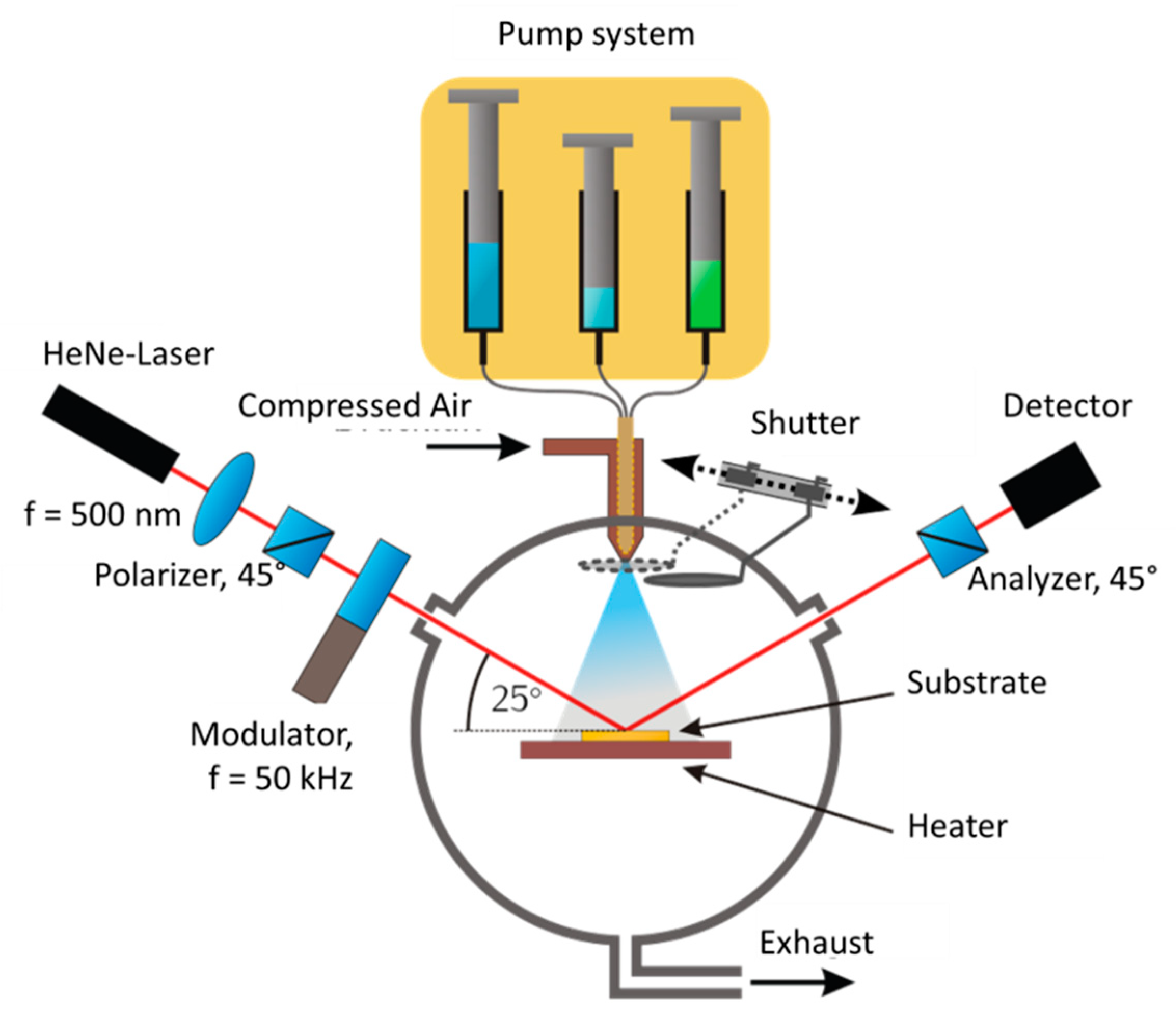
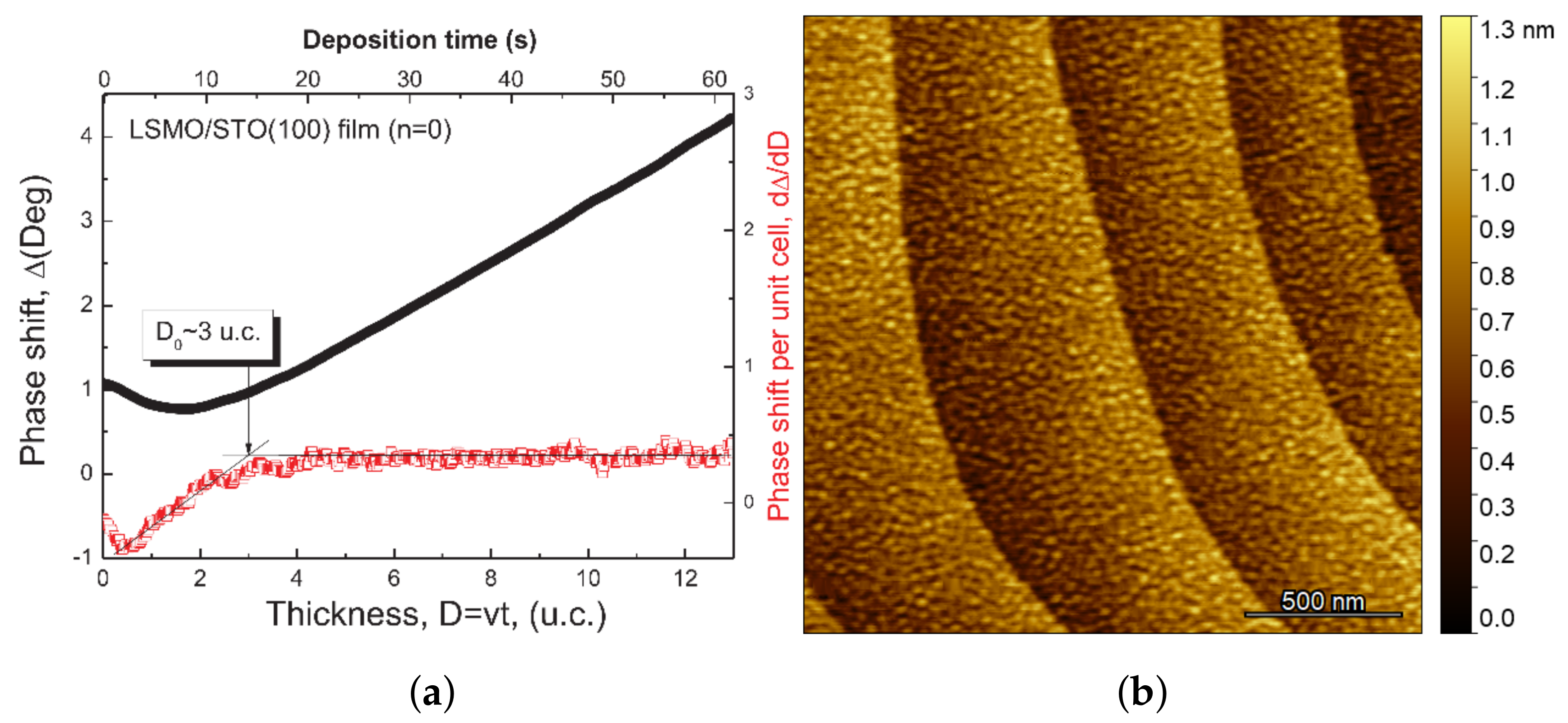
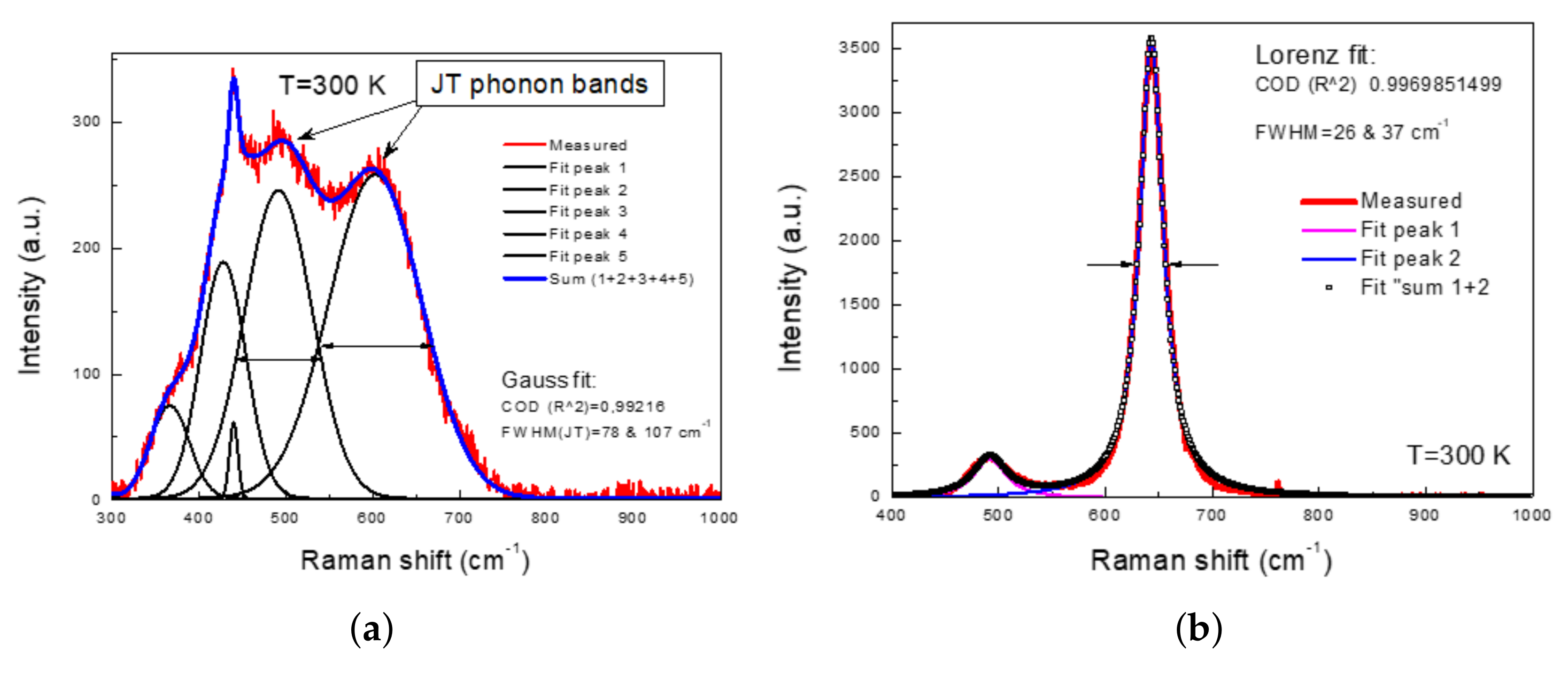

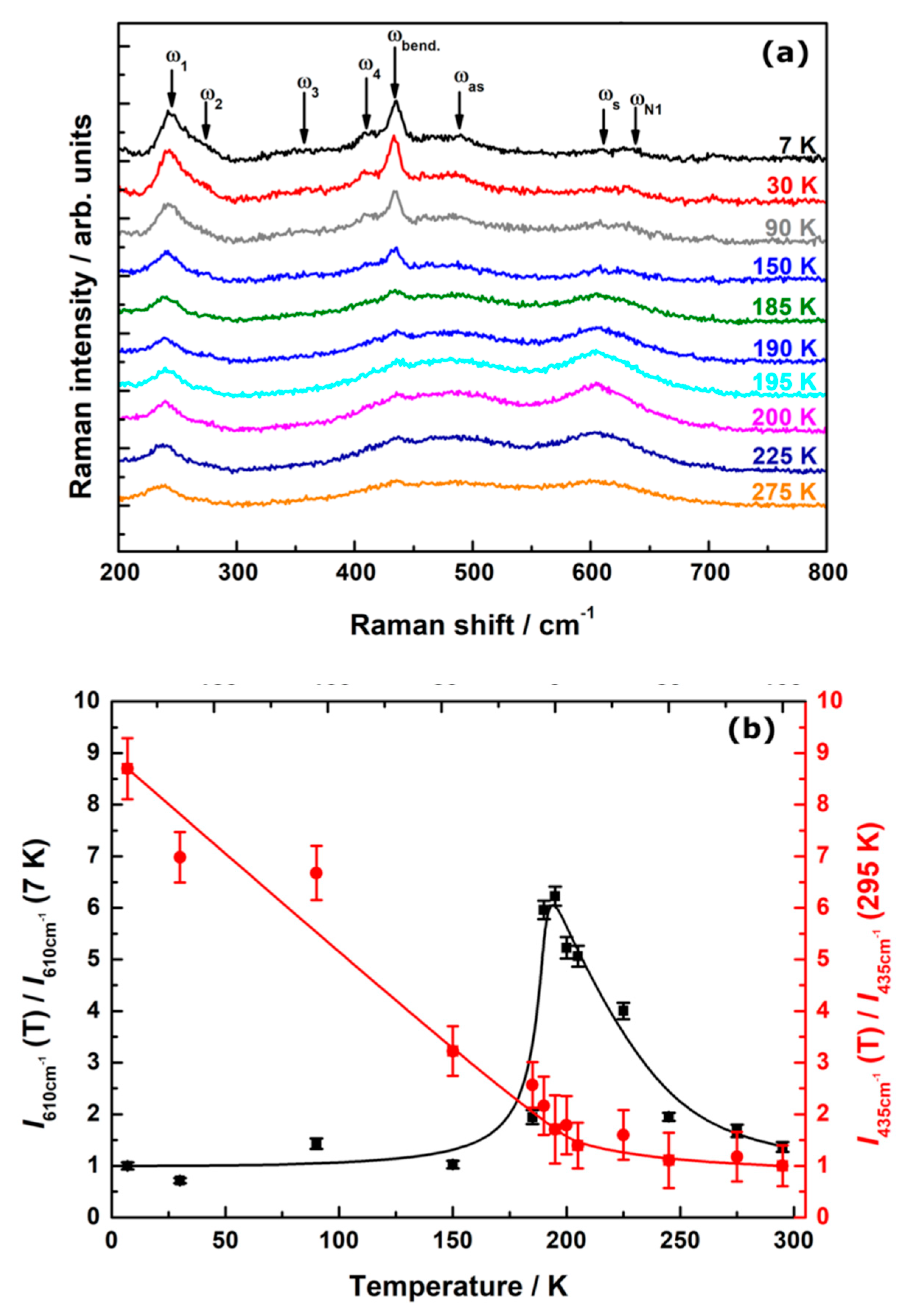
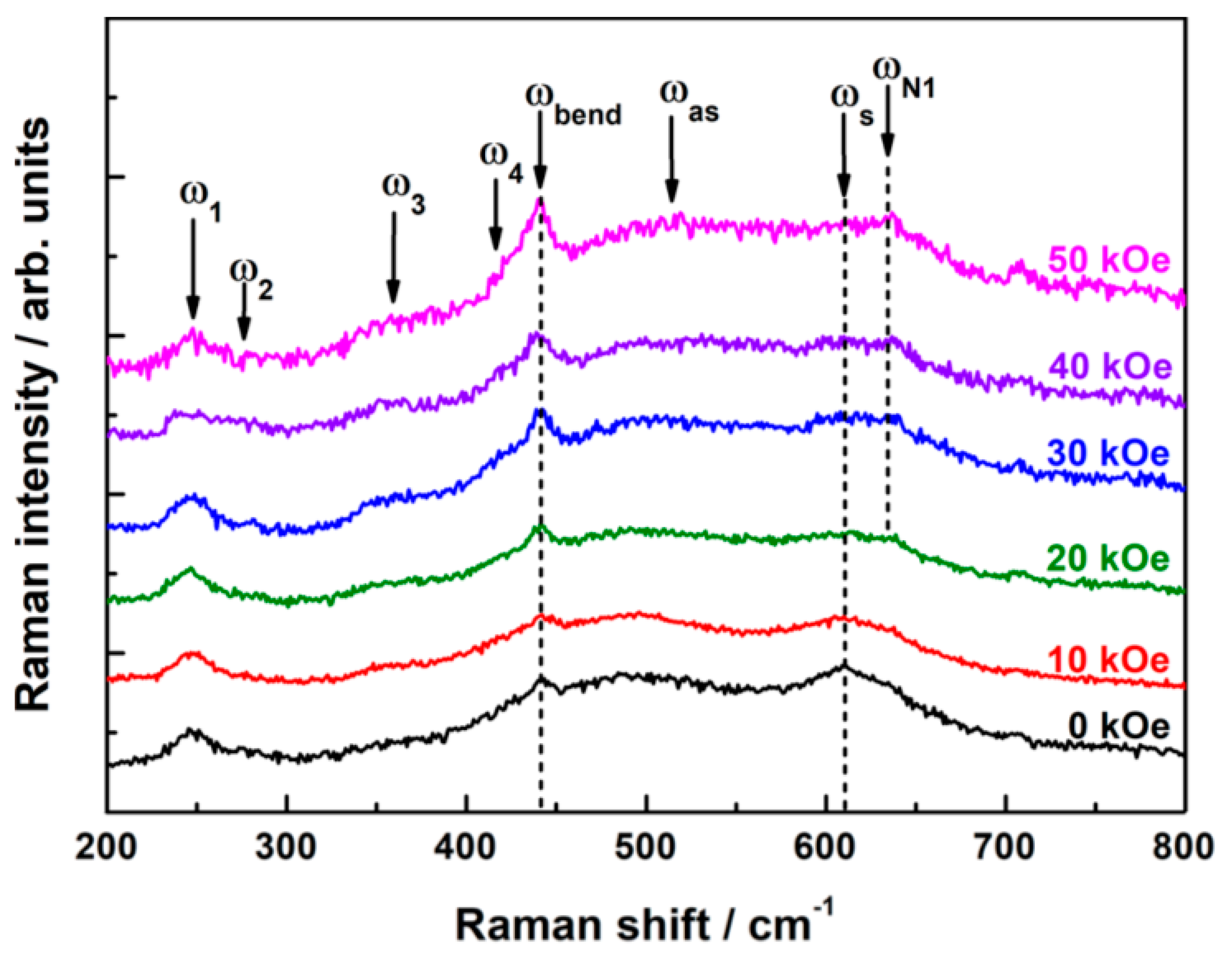
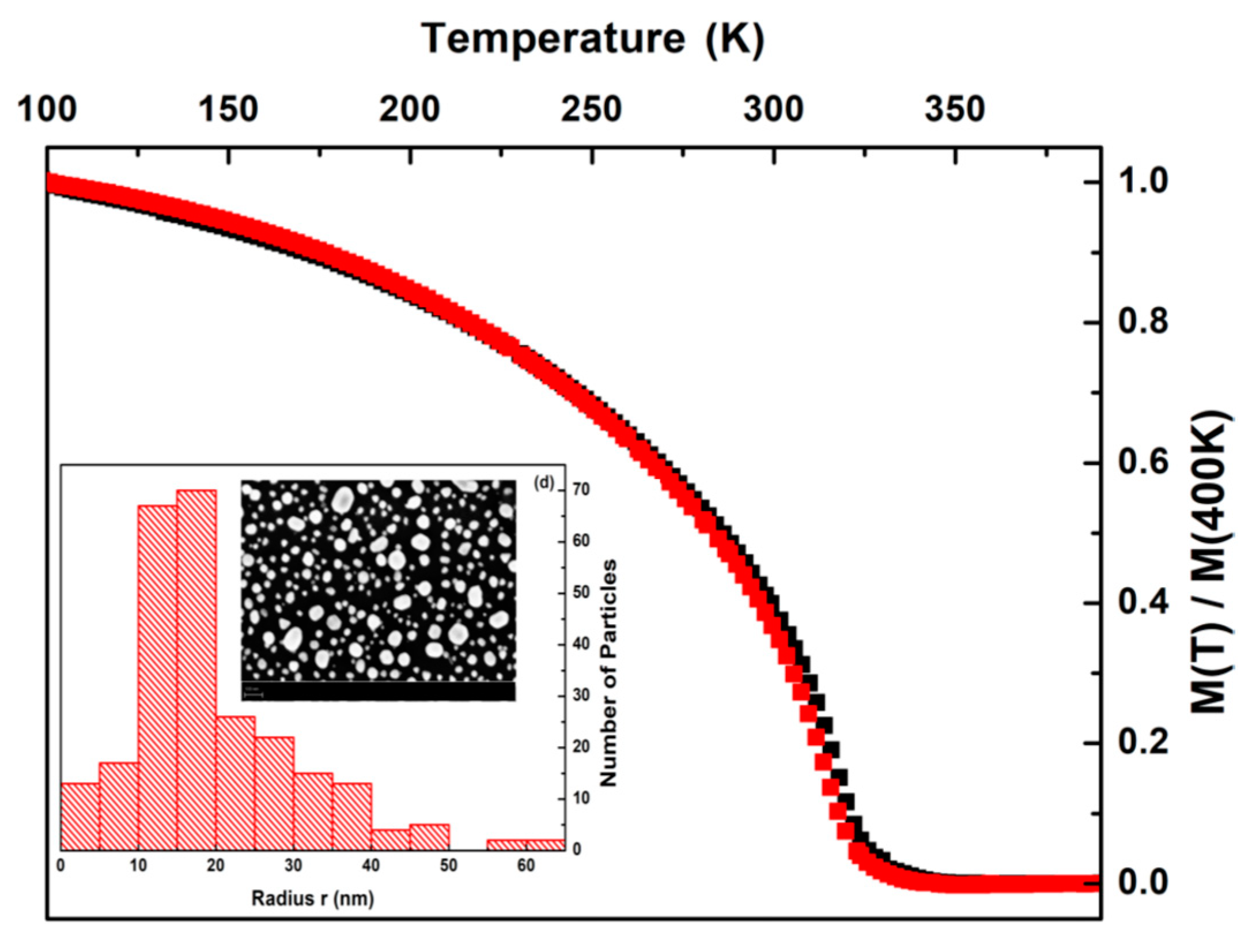
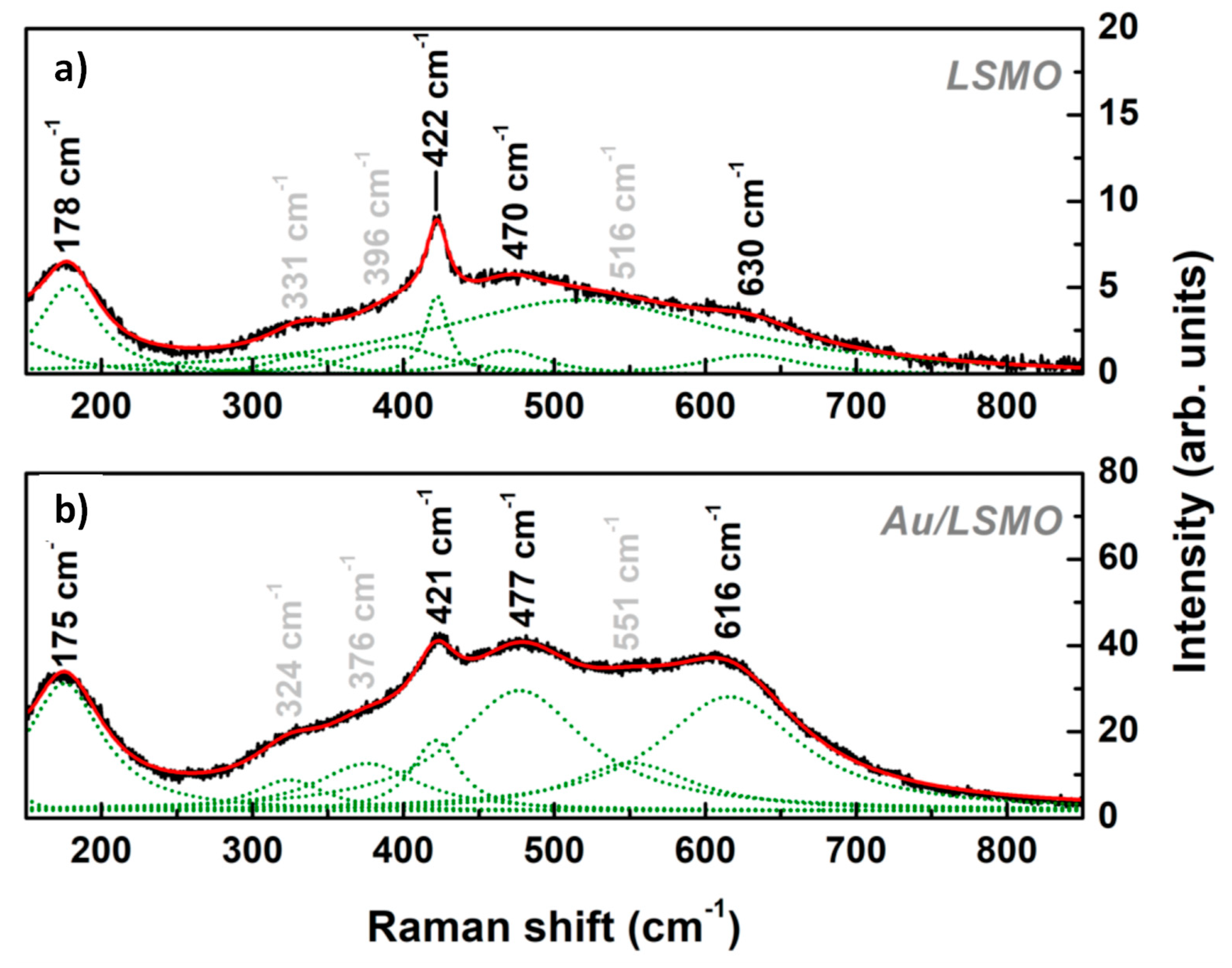
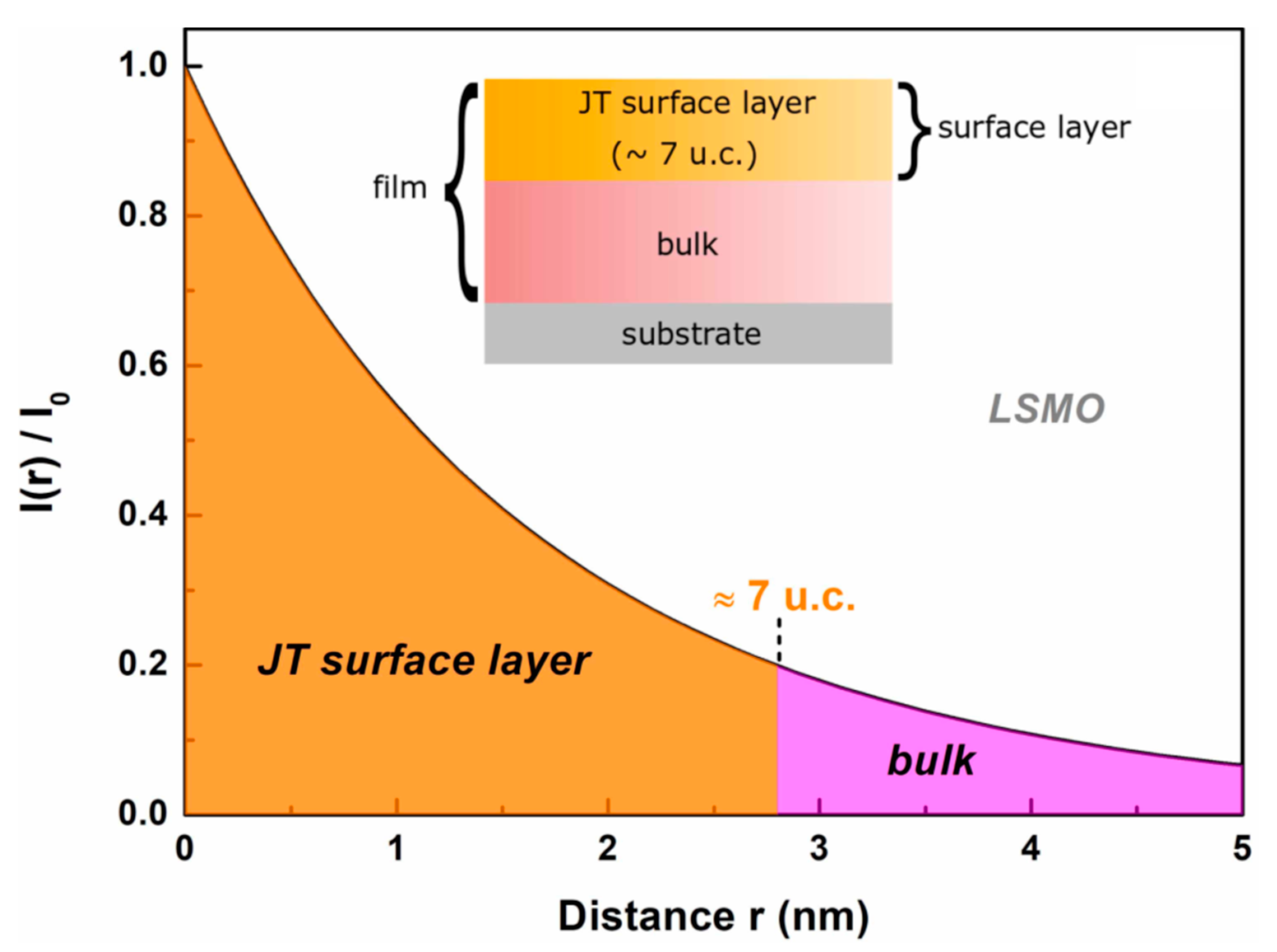
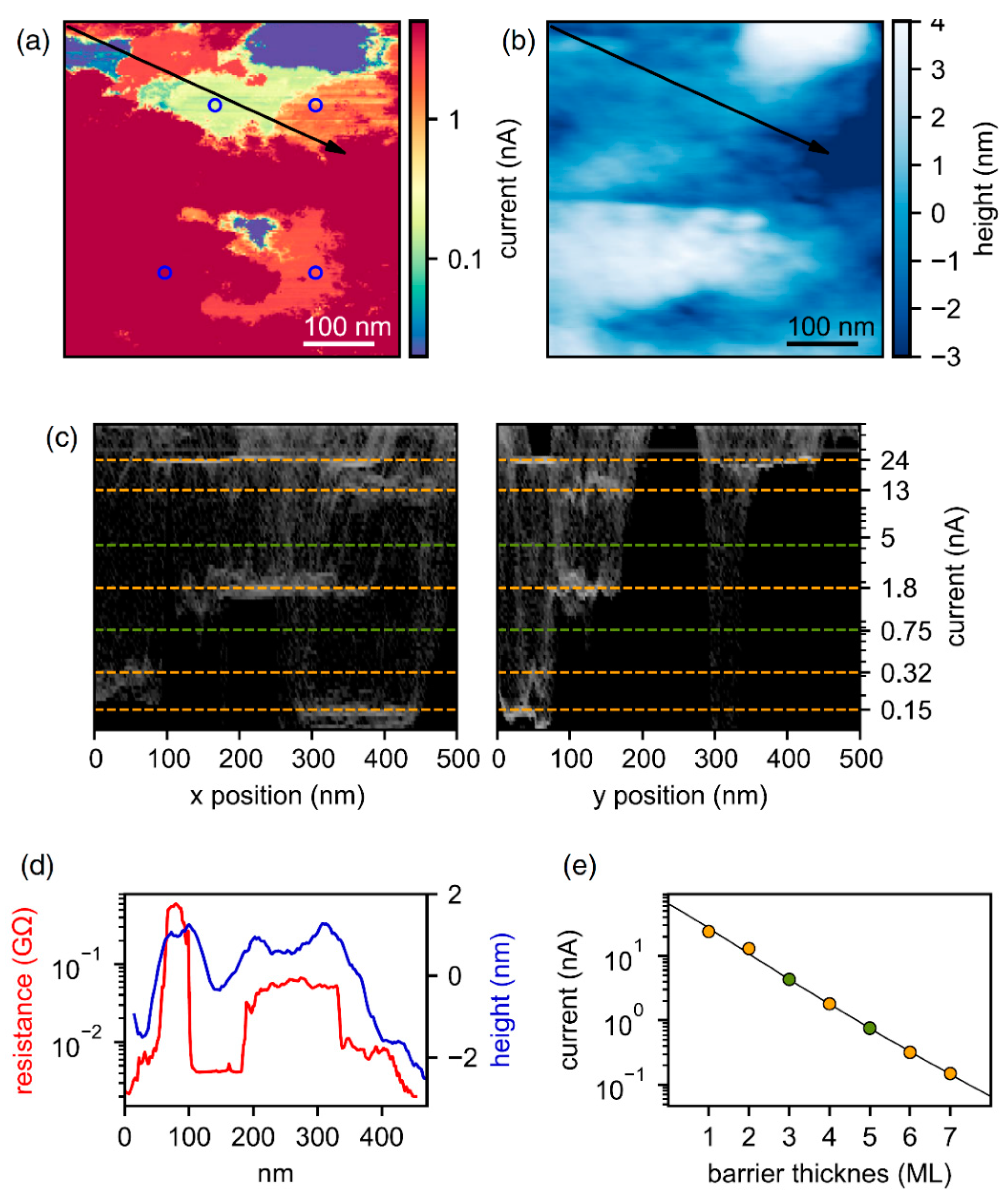
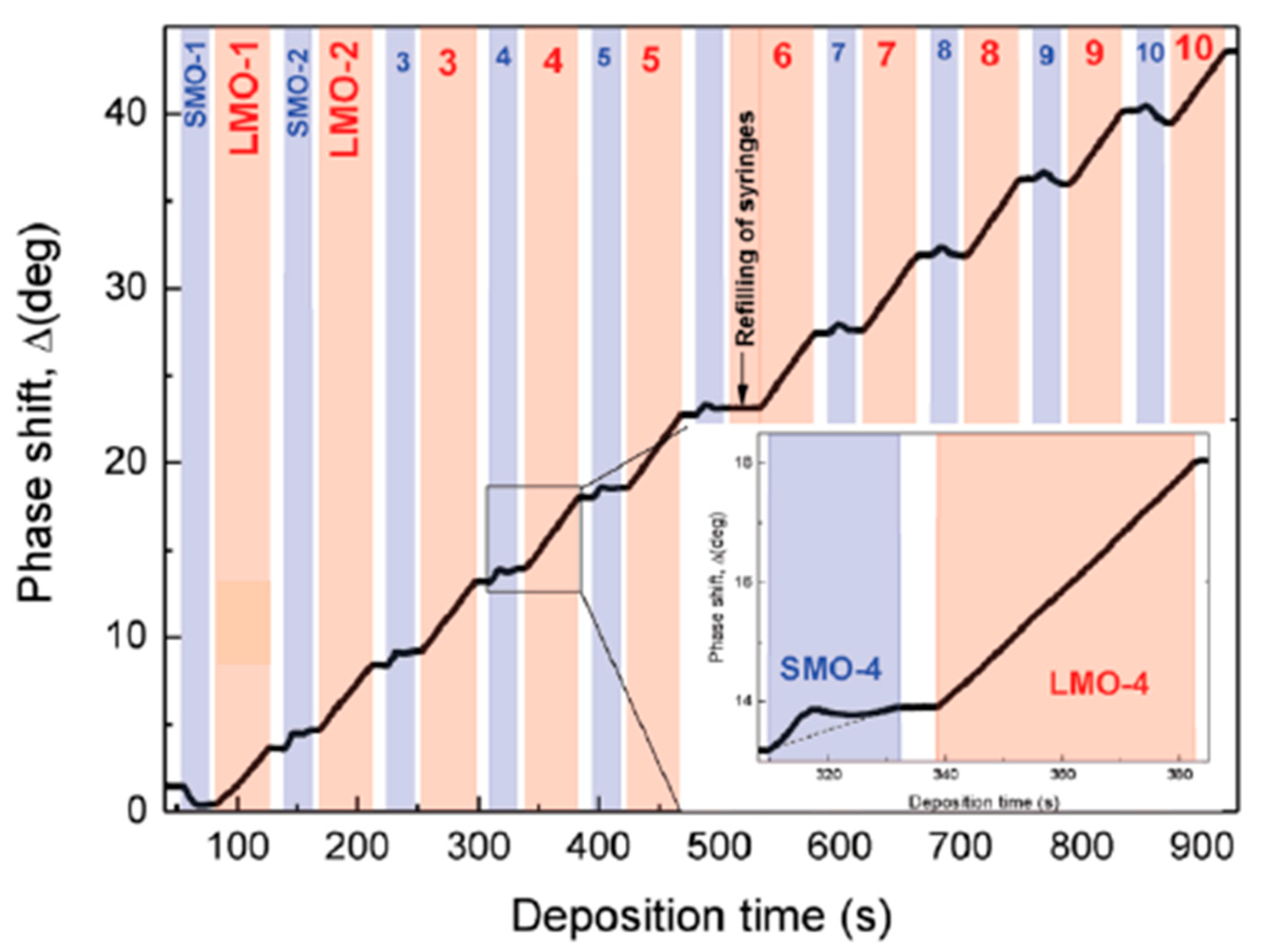
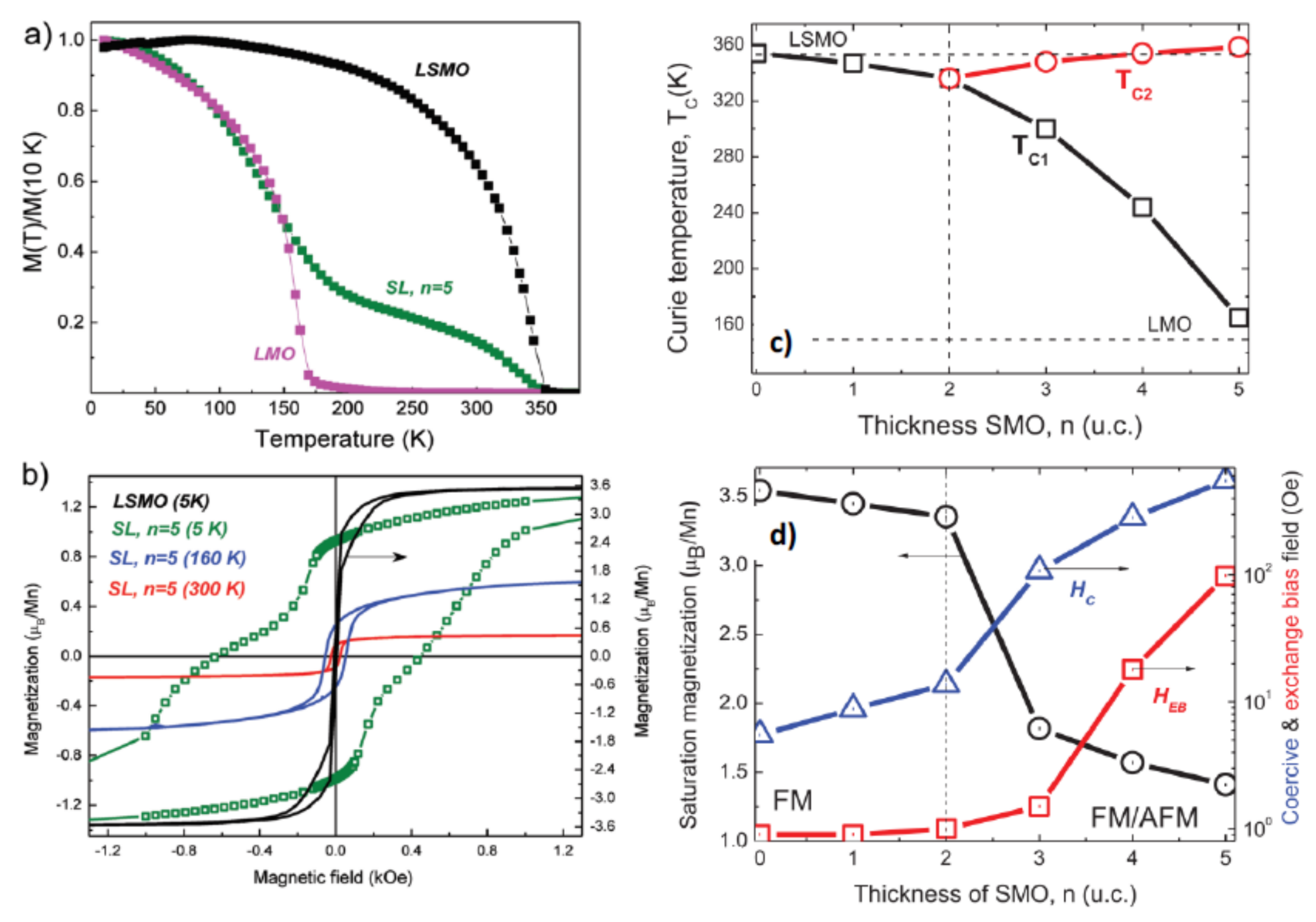
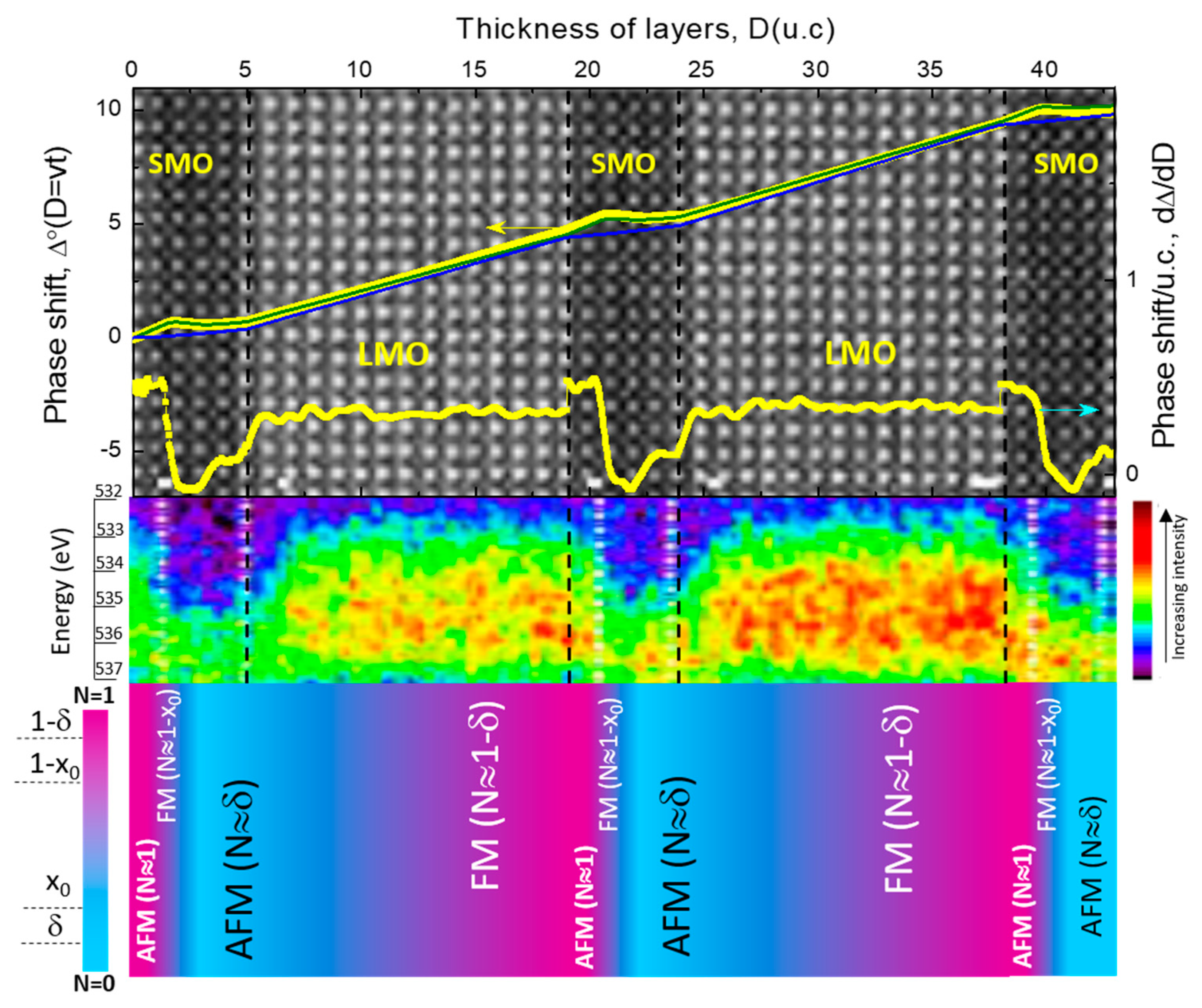
© 2019 by the authors. Licensee MDPI, Basel, Switzerland. This article is an open access article distributed under the terms and conditions of the Creative Commons Attribution (CC BY) license (http://creativecommons.org/licenses/by/4.0/).
Share and Cite
Moshnyaga, V.; Samwer, K. Polaronic Emergent Phases in Manganite-based Heterostructures. Crystals 2019, 9, 489. https://doi.org/10.3390/cryst9100489
Moshnyaga V, Samwer K. Polaronic Emergent Phases in Manganite-based Heterostructures. Crystals. 2019; 9(10):489. https://doi.org/10.3390/cryst9100489
Chicago/Turabian StyleMoshnyaga, Vasily, and Konrad Samwer. 2019. "Polaronic Emergent Phases in Manganite-based Heterostructures" Crystals 9, no. 10: 489. https://doi.org/10.3390/cryst9100489
APA StyleMoshnyaga, V., & Samwer, K. (2019). Polaronic Emergent Phases in Manganite-based Heterostructures. Crystals, 9(10), 489. https://doi.org/10.3390/cryst9100489



